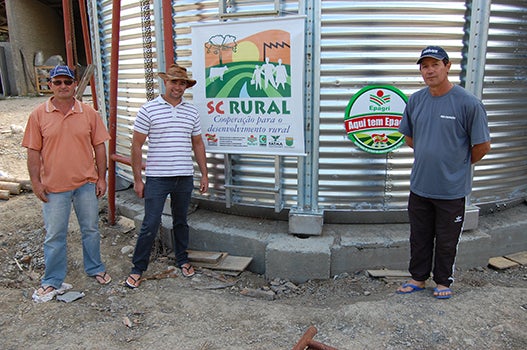
A matching grant enabled the Brazilian cooperative Coopervoltapinho to build a rice silo. All photos by Romeu Scirea.
Imagine driving along a rural road and seeing many small farms, all growing flourishing crops. Would you know how the farmers obtained the funds to plant these crops, enhance their productivity, and deliver them to market?
The story of Coopervoltapinho, an agricultural cooperative located in Santa Catarina State in southern Brazil, illustrates the important role played by financing in supporting smallholder agriculture. Coopervoltapinho, whose 180 members are served by approximately 3 full time employees using equipment owned by the cooperative and working out of the cooperative’s own facilities, serves an attractive niche market for rice, faces more demand than it can supply, and has room to grow. These characteristics normally would make it very attractive for investors and lending institutions. But Coopervoltapinho has a problem: it is not a firm, but a cooperative. In Brazil as in many other countries, even when cooperatives are operated for profit, they are seen as risky investments, mainly due to perceived weaknesses in their governance structures, decision making processes, and management capacity.
Financial institutions that are reluctant to lend to cooperatives frequently bring up examples in which the president of a cooperative absconded with the members’ money, citing this as evidence that all cooperatives are unreliable. But at least in Brazil, where agriculture cooperatives often compete with the most powerful agrifood conglomerates, this characterization is incorrect. For this reason, the World Bank has partnered with several states (Santa Catarina, Sao Paulo, Parana, Pernambuco, Rio Grande do Norte, Ceara, Acre, and Rio de Janeiro) to tackle what economists would characterize as a market failure, providing matching grants to support business plans presented by agricultural cooperatives and producer associations.
Santa Catarina is one of the states that has received financing from the World Bank. The SC Rural Program has had a major impact in terms of improving the competitiveness and increasing the revenues of family farmer organizations, including cooperatives and producer associations. A recent impact evaluation showed that family farmer organizations that received matching grants to support investment in agribusiness plans more than doubled their revenues compared to those who did not receive matching grants. Furthermore, the matching grants were able to leverage more than 50% in counterpart funding sourced from commercial loans and/or the farmers’ own resources.

Coopervoltapinho was one of the beneficiaries of Santa Catarina Rural Program
Providing matching grants to finance investment needs of cooperatives and producer associations is an example of an innovative approach to solving market failures in the agrifinance market. One of the factors that allowed Brazil to transform itself from being a net food importer in the 1970s to being a net food exporter and a global agrifood power today has been its public policy to support the expansion of rural credit. Banks in Brazil are mandated by law to lend at least 35% of their deposits to the agriculture sector, and agriculture credit is the main policy instrument used by the government to influence farmers’ production and marketing decisions.
The sums directed by these programs into the agriculture sector are vast, and the impacts are enormous. Brazil’s ABC Program, the world’s largest Climate Smart Agriculture Program, is funded through a dedicated line of credit. The biggest policy event of the year is the announcement of how much money the government will make available for rural credit.
While there can be no doubt that the generous support provided to the agriculture sector has had significant impacts, changes are inevitable, because Brazil continues to rely on an agrifinance system that, although successful in the past, is no longer sustainable.
Until recently, many Brazilian farmers were paying negative real interest rates, thanks to the heavy subsidies applied to interest rates for rural credit. This meant that farmers did not have to produce anything to make money. They simply needed to take out a loan at the subsidized rate, deposit the money in a regular deposit account, and when they repaid the loan, they would have money left over. Meanwhile, cooperatives and producer associations that were struggling to compete with well-financed private agrifood companies did not have access to finance.
In view of the current fiscal crisis in Brazil -- and given the clear need for the agriculture sector to keep growing and competing in a global food market -- agrifinance policies are coming under increasing pressure to adapt to the changing conditions.
In a recent article, Pedro Abel Vieira, Antônio Luiz Moraes, Elisio Contini and I argued that since funding for agriculture credit is no longer growing, there is need to find new and more cost-effective instruments to replace the matching grant schemes that have proved so dominant in the past. Alternatives to directed and subsidized agriculture credit include (among others) helping farmers manage their risk through more and better agriculture insurance (currently at 18% coverage in Brazil compared to more than 50% coverage in Argentina) and establishing partial credit guarantees to attract commercial bank funding to the sector.
For the immediate future, cooperatives such as Coopervoltapinho will remain partially dependent on public programs to access financial resources. But if policy reforms can be introduced to provide them with instruments to better manage agriculture risks while moving toward a market-based agrifinance system, in a few years they may be able to obtain all the financial resources they need through the local financial institution.


Join the Conversation